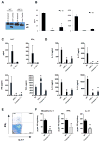The inflammasome drives protective Th1 and Th17 cellular responses in disseminated candidiasis
- PMID: 21681738
- PMCID: PMC3939807
- DOI: 10.1002/eji.201041226
The inflammasome drives protective Th1 and Th17 cellular responses in disseminated candidiasis
Abstract
The Nlrp3 inflammasome has been proposed to play an important role in antifungal host defense. However, studies exploring the role of the inflammasome in antifungal host defense have been limited to the direct effects on IL-1β processing. Although IL-1β has important direct effects on the innate immune response, important effects of the caspase-1-dependent cytokines IL-1β and IL-18 are exerted on the initiation of the adaptive Th1 and Th17 cellular responses. No studies have been employed to assess the impact of the inflammasome on the Th1/Th17 defense mechanisms in vivo during candidiasis. In the present study, we demonstrate an essential role for caspase-1 and ASC (apoptosis-associated speck-like protein containing a caspase recruitment domain) in disseminated candidiasis through regulating antifungal Th1 and Th17 responses. Caspase-1(-/-) and ASC(-/-) mice display diminished Th1/Th17 responses, followed by increased fungal outgrowth and lower survival. These observations identify a critical role for the inflammasome in controlling protective adaptive immune responses during invasive fungal infection.
Copyright © 2011 WILEY-VCH Verlag GmbH & Co. KGaA, Weinheim.
Figures




Similar articles
-
Inflammasome adaptor protein Apoptosis-associated speck-like protein containing CARD (ASC) is critical for the immune response and survival in west Nile virus encephalitis.J Virol. 2013 Apr;87(7):3655-67. doi: 10.1128/JVI.02667-12. Epub 2013 Jan 9. J Virol. 2013. PMID: 23302887 Free PMC article.
-
Inflammasome and Fas-Mediated IL-1β Contributes to Th17/Th1 Cell Induction in Pathogenic Bacterial Infection In Vivo.J Immunol. 2017 Aug 1;199(3):1122-1130. doi: 10.4049/jimmunol.1601373. Epub 2017 Jul 3. J Immunol. 2017. PMID: 28674179
-
Inflammasome-mediated GSDMD activation facilitates escape of Candida albicans from macrophages.Nat Commun. 2021 Nov 18;12(1):6699. doi: 10.1038/s41467-021-27034-9. Nat Commun. 2021. PMID: 34795266 Free PMC article.
-
Adaptive immune responses to Candida albicans infection.Virulence. 2015;6(4):327-37. doi: 10.1080/21505594.2015.1004977. Epub 2015 Jan 21. Virulence. 2015. PMID: 25607781 Free PMC article. Review.
-
Cross-regulation between the IL-1β/IL-18 processing inflammasome and other inflammatory cytokines.Curr Opin Immunol. 2011 Oct;23(5):591-7. doi: 10.1016/j.coi.2011.07.005. Epub 2011 Aug 10. Curr Opin Immunol. 2011. PMID: 21839623 Free PMC article. Review.
Cited by
-
Control of innate and adaptive immunity by the inflammasome.Microbes Infect. 2012 Nov;14(14):1263-70. doi: 10.1016/j.micinf.2012.07.007. Epub 2012 Jul 24. Microbes Infect. 2012. PMID: 22841804 Free PMC article. Review.
-
Total-Body Irradiation Exacerbates Dissemination of Cutaneous Candida Albicans Infection.Radiat Res. 2016 Nov;186(5):436-446. doi: 10.1667/RR14295.1. Epub 2016 Oct 6. Radiat Res. 2016. PMID: 27710703 Free PMC article.
-
The pathogen Candida albicans hijacks pyroptosis for escape from macrophages.mBio. 2014 Mar 25;5(2):e00003-14. doi: 10.1128/mBio.00003-14. mBio. 2014. PMID: 24667705 Free PMC article.
-
Mechanisms of Cholera Toxin in the Modulation of TH17 Responses.Crit Rev Immunol. 2015;35(2):135-52. doi: 10.1615/critrevimmunol.2015012295. Crit Rev Immunol. 2015. PMID: 26351147 Free PMC article. Review.
-
Identification of Dual-Target Compounds with Antifungal and Anti-NLRP3 Inflammasome Activity.ACS Infect Dis. 2021 Aug 13;7(8):2522-2535. doi: 10.1021/acsinfecdis.1c00270. Epub 2021 Jul 14. ACS Infect Dis. 2021. PMID: 34260210 Free PMC article.
References
-
- Martinon F, Burns K, Tschopp J. The inflammasome: a molecular platform triggering activation of inflammatory caspases and processing of proIL-beta. Mol Cell. 2002;10:417–426. - PubMed
-
- Gross O, Poeck H, Bscheider M, Dostert C, Hannesschlager N, Endres S, Hartmann G, Tardivel A, Schweighoffer E, Tybulewicz V, Mocsai A, Tschopp J, Ruland J. Syk kinase signalling couples to the Nlrp3 inflammasome for anti-fungal host defence. Nature. 2009;459:433–436. - PubMed
-
- Dinarello CA. IL-18: A Th1-inducing, proinflammatory cytokine and a new member of the IL-1 family. J Allergy Clin Immunol. 1999;103:11–24. - PubMed
Publication types
MeSH terms
Substances
Grants and funding
LinkOut - more resources
Full Text Sources
Medical
Molecular Biology Databases
Miscellaneous

